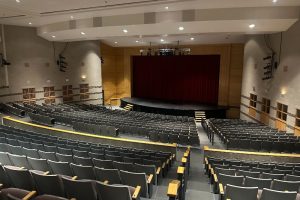Remote Learning Academy needs some modifications
Photo by Andrew Neel from Pexels
A woman sits in her room while doing work remotely
October 7, 2020
7:00 a.m.: Get ready for school.
7:35 a.m. – 11:00 a.m.: Stare at a screen trapped in a room with absolutely no in-person human interaction (other than my family of course).
That routine has become my norm for the past few weeks and probably will be up until it’s safe to go back to school.
On a typical Pod B week, I join a meet with an average of three other RLA-B students. The teacher addresses us, but after that point, the technological difficulties create a division far more frustrating than the distance. In three of my classes, just in the past two weeks, the other remote students and I have spent fifty minutes staring at a frozen screen with audio as the only form of connection to the in-person class. That probably seems unproblematic at the beginning, but just after the first ten minutes, it turns into pure awkwardness, and frankly boredom.
In other classes where technology is not a problem, it feels like RLA students are disregarded, which is not too motivating.
When I signed up for remote learning, I did so with low expectations as I was aware many students chose hybrid learning over the remote learning academy. I predicted teachers would give more attention to the students in-class since they were the majority. However, I didn’t expect remote students to be regarded in class by the teacher less than five times a day.
Just to be clear, this has been the situation in only three of my classes, which has allowed me to make a comparison to classes where I do feel included in class conversations. When there are around three people present on a google meet, I’ve noticed the teacher doesn’t give as much consideration for remote students since the majority of students are in class. However, classes with a higher number of virtual students are given an equal amount of attention; the reason being that the teacher require synchronous meetings in the morning and the afternoon. Since all students are required to join the class, there are a higher number of people on the google meet, and consequently more teacher attention. Due to this reason, it might be more beneficial to require synchronous work both in the mornings and afternoons.
A few people I’ve talked to have stated it’s been less stressful when we have asynchronous work which I agree with, to an extent. Yes, we get more flexibility, but, at least for me, it has been less stressful to the point where there seems to be no structure (disregarding the synchronous period).
During asynchronous working periods, I’ve found myself feeling unmotivated to do the assigned work which has led to procrastination and ultimately more stress. Whereas, full synchronous learning would not only add structure, but it would also promote some more interaction based-learning: something that is not feasible when students have asynchronous work.
Through this opinion, I am in no way trying to criticize the teachers at WA. All staff have put so much time and effort into adapting to these unprecedented circumstances for which I am incredibly grateful. The purpose of this article is to simply show some modifications that can be made so education can improve for students, both RLA and hybrid.








